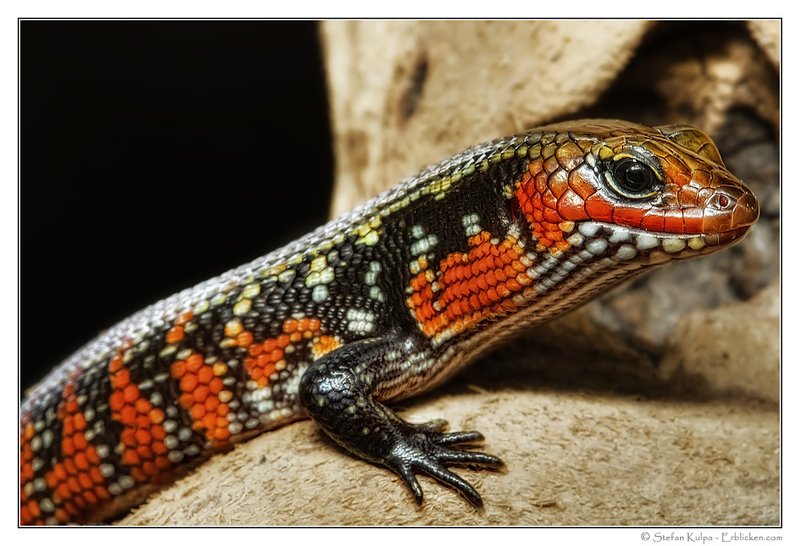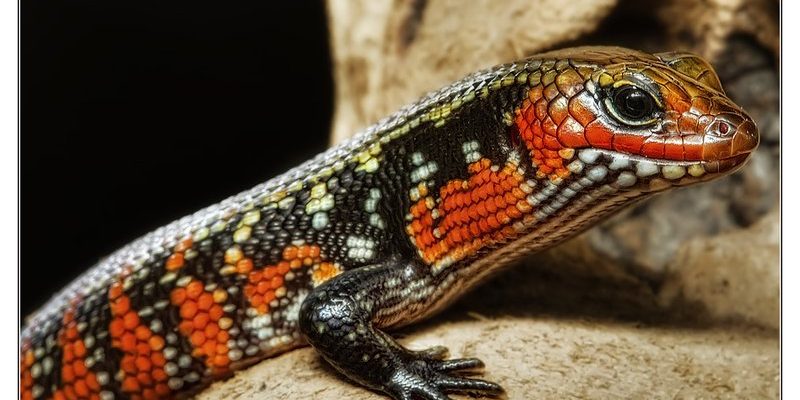
Native to the forests of West Africa, fire skinks have some impressive features that make them stand out in the reptile world. Their bright red and orange patterns are not just for looks; they also help them adapt to their environment. It’s like nature’s own design, combining beauty with practicality. If you’re thinking about getting one or simply curious about these fascinating creatures, stick around! Here are ten cool facts about fire skinks that’ll make you appreciate them even more.
1. Vibrant Colors and Patterns
One of the first things you’ll notice about fire skinks is their vibrant coloration. They typically sport bright red, orange, or yellow stripes against a darker background, making them visually stunning. This striking pattern is more than just a pretty face, though. It plays a crucial role in their survival. The colors help them blend in with their natural habitat, allowing them to hide from predators, which is essential for their safety in the wild.
These colors also serve to attract mates during the breeding season. Just like peacocks flaunt their colorful feathers to impress, fire skinks use their dazzling hues to attract potential partners. Isn’t it amazing how nature works in such brilliant ways?
2. Habitat and Range
Fire skinks are primarily found in tropical forests across West Africa, particularly in countries like Cameroon and Gabon. They thrive in warm, humid environments where they can easily find shelter among the rocks and leaf litter. This habitat provides them with ample opportunities to hunt for insects, which make up the bulk of their diet.
You might be wondering why they prefer such specific locations. Well, these areas offer the perfect balance of cover and food. The dense foliage allows them to hide from predators, while the abundant insect population ensures they get enough nutrition. Think of it as their own little buffet where they can eat and stay safe at the same time!
3. Diet and Feeding Habits
When it comes to meals, fire skinks are primarily insectivores. They love to munch on crickets, mealworms, and other small bugs. These lizards are opportunistic feeders, meaning they’ll eagerly hunt down whatever insect comes their way. You might find them darting out from their hiding places to grab a meal, showcasing their impressive agility.
It’s important to mimic this diet if you decide to keep a fire skink as a pet. Providing a diverse array of insects ensures they get the right nutrients. Honestly, you want to be a good pet parent, right? So, make sure their diet is as colorful and varied as they are!
4. Behavior and Activity Level
Fire skinks are known for their lively and curious personalities. They’re not just couch potatoes; these little guys are quite active! They’re generally diurnal, meaning they’re most active during the day. You might catch them basking under a light or exploring their enclosure. Watching a fire skink in action is like observing a tiny acrobat—full of energy and eager to discover.
However, they can be a bit shy. If they feel threatened or stressed, they’ll quickly dart back to their hiding spots. So, if you’re thinking about having one at home, make sure to create a safe and comfortable environment for them. This way, they’ll feel more secure and confident to show off their playful side!
5. Lifespan and Care Requirements
With proper care, fire skinks can live up to 10 years or more in captivity. This longevity means you’ll have a lively companion for quite a while! However, keeping a fire skink happy and healthy requires understanding their specific needs. They thrive in warm, humid environments, so maintaining the right temperature and humidity levels is crucial.
You’ll want to provide a habitat with plenty of hiding spots, like logs and rocks, where they can feel secure. Regular cleaning and providing fresh food and water are also key to their health. Think of it like hosting a small party; you want everything to be just right for your guest!
6. Unique Defense Mechanisms
Like many reptiles, fire skinks have developed some interesting defense tactics to evade predators. Their bright colors can serve as a warning to potential threats, signaling that they might not be tasty after all. Additionally, if they feel particularly threatened, they might resort to a clever trick: they can shed their tails!
While this might sound extreme, losing part of their tail can distract a predator long enough for the skink to escape. The tail will eventually regenerate, allowing the fire skink to continue living its life. Isn’t that a fascinating survival strategy? It’s like having a built-in smoke bomb when things get tough!
7. Differences Between Males and Females
Like many species, there are noticeable differences between male and female fire skinks. Males tend to have brighter colors and larger bodies compared to females. During breeding seasons, the differences become even more pronounced, as males often display more vibrant patterns to attract females.
If you’re considering breeding them, it’s crucial to know these differences. This knowledge can help you create a suitable environment for them to thrive and reproduce. Honestly, knowing who’s who in your skink community can really help reduce any potential conflicts!
8. Ideal Tank Setup for Fire Skinks
Setting up a proper tank for your fire skink can feel a bit daunting, but it’s essential for their wellbeing. A good rule of thumb is to start with a tank that’s at least 20 gallons. It should be well-ventilated and contain a substrate that mimics their natural habitat. Things like coconut fiber or reptile carpet can work nicely.
Inside the tank, include plenty of hiding spots filled with rocks, logs, and plants. This setup will provide them with both security and stimulation. Add a water dish to ensure they stay hydrated, and make sure to keep the temperature and humidity levels within their preferred range. It’s like creating a mini rainforest just for your skink!
9. Social Animals: Are They Friendly?
You might be wondering if fire skinks can be kept together or if they prefer to be solo. Generally, fire skinks can tolerate the presence of their own kind, especially if raised together. However, it’s crucial to monitor them for any signs of aggression. Sometimes, male skinks can be territorial, so separating them can prevent conflicts.
In terms of handling, fire skinks can become accustomed to being held, but patience is key. Spend time with them regularly to help them feel comfortable. It’s like building a friendship; the more you interact, the more trust you’ll develop.
10. Conservation Status and Threats
Sadly, like many reptiles, fire skinks face threats in the wild. Habitat loss due to deforestation and illegal pet trade puts pressure on their populations. Understanding this can help you appreciate how vital it is to protect their natural habitats.
If you’re considering a fire skink as a pet, think about adopting from a reputable breeder rather than taking one from the wild. This not only ensures you have a healthy pet but also helps support conservation efforts. Let’s be responsible and do our part to keep these beautiful creatures thriving.
In conclusion, fire skinks are incredible little lizards with vibrant colors, fascinating behaviors, and unique adaptations. Whether you’re thinking about adding one to your family or simply admire them from afar, understanding these creatures can deepen your appreciation for the wonders of nature. So, next time you come across a fire skink, remember the journey of survival and beauty that these reptiles embody!

